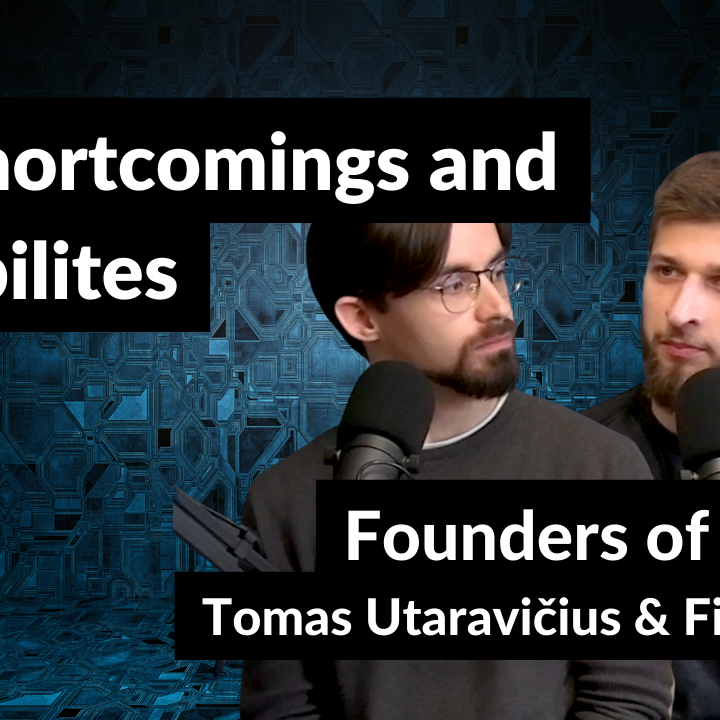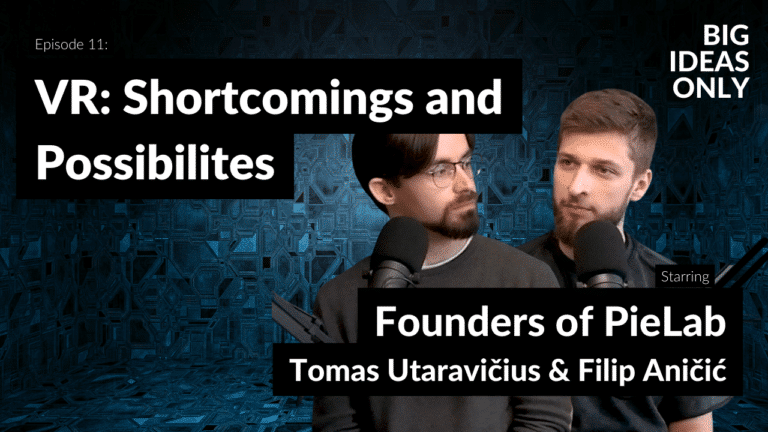About the Episode
In this episode of Big Ideas Only, we discuss the topic of black holes, white holes, and wormholes: what are they and why are they so interesting to look at.
Today, our guest is Ole Eggers Bjælde, an astrophysicist at Aarhus University. He’ll explain what black holes are, how they work, and what would happen if you get sucked into one.
Your host is Mikkel Svold, CEO of Montanus, who will guide you through this interesting topic of Black Holes.
Listed below are the most essential timestamps from the podcast episode to make it easier for you to find the topics that interest you.
01:04 What is astrophysics?
04:03 What is a black hole?
04:46 How a black hole works
08:58 What is inside a black hole?
09:27 Wormholes
10:31 White holes
11:50 A black hole is something you couldn’t see until a few years ago
14:09 The event horizon
17:38 Relativity
21:10 A black hole is almost forever
27:15 What fascinates Ole about black holes
29:40 Hopes for the future
32:39 Where to find Ole
33:02 Outro
Recommended
Relevant Links from the Episode
Mikkel (00:00):
Hello, and welcome to Big Ideas Only, a podcast brought to you by Montanus, a company specialized in producing high quality content for marketing departments in high tech companies. I’m Mikkel Svold. And today, we are talking about something that I’ve always found a bit hard to understand completely, or at least parts of it. So we are talking about black holes. And to answer this question, I’ve invited Ole Eggers Bjælde into the studio. Welcome Ole.
Ole (00:50):
Thanks.
Mikkel (00:52):
And Ole is an astrophysicist at Aarhus University. And he made me say that word so I might have said it wrong.
Ole (00:59):
No, that’s very good.
Mikkel (01:00):
Astrophysicist at Aarhus University in Denmark. And Ole, maybe we should just start by defining what is astrophysics and what do an astrophysicist do?
Ole (01:10):
That’s a good way to start, I guess. Well, astrophysics or astronomy, those are very close, is the study of the universe and things in the universe. So that’s the study of the Earth, the Sun, the Solar System and beyond that. So we’re trying to understand the processes of what’s going on. And then to give an example, one could say, so okay, we know about the Sun. We know how old it is. That’s astrophysics. We also know what happened to the Sun in the past, and we also know what will happen to the Sun in the future. That’s all examples from astrophysics.
Mikkel (01:48):
And how do we know what happens in the future?
Ole (01:48):
We know it because there are really a lot of stars in the universe, so we can observe these stars. And some of them are similar to the Sun and some are at a later stage in the life and some are at an earlier stage. So we have very good models based on those observations of stars that can tell us basically about any star and its past and future.
Mikkel (02:10):
Okay. Yeah. So you can’t compare one star to itself at points in time, but you can compare one star of a certain type to another star of the same type, but which is older or younger or whatever.
Ole (02:24):
Absolutely. Yeah, absolutely. And so for the Sun, for instance, we know actually quite accurately what has happened in the past with the Sun, if it was warmer or colder and-
Mikkel (02:34):
Because of observing
Ole (02:37):
Yeah. And then we make these models using math and computational physics that we put into a computer. And then we of generate a lifetime for a particular star given its mass and some other parameters that we put into a model like that.
Mikkel (02:55):
Now this is not actually the way we should go already. We’re already sidetracking on this interview. But where are we in the Sun? How old? Are we close to the end when you compare it?
Ole (03:08):
We are halfway through. So the Sun and-
Mikkel (03:09):
It’s got a good amount of time still.
Ole (03:11):
Yeah. One could say that. So far, four and a half billion years have passed and approximately the same amount will pass after that before weird stuff begins to happen.
Mikkel (03:25):
Okay. Okay. And we won’t be around by then, so don’t worry.
Ole (03:28):
Exactly.
Mikkel (03:29):
All right. Let’s come back to today’s topic, black holes. I’ve always found them quite fascinating.
Ole (03:37):
Me too.
Mikkel (03:38):
Mainly because there’s so many things about them that I don’t understand, although I do understand some of the things. I do understand that things can’t escape because of gravity and blah, blah, blah. And I think we should talk into that because I think that’s complex, but I just somehow grasped the idea, I was just about to say a couple of hours ago, a couple of years ago. But can you start by explaining what is a black hole?
Ole (04:10):
Sure. A nice way to view what a black hole is, is to think of it as a spherical volume in space, which is like a different part, or one could say a specific part in the universe where gravity is so intense that it just wins the battle with all other forces. And so that means, regardless of what comes into this volume of space, it can’t escape.
Mikkel (04:42):
And how does that work?
Ole (04:46):
Well, it works in the way that… Usually the most common type of black hole is a star that has lived its life. And then at some point in its life, it collapses into this very dense object. And for the very biggest stars, the object that it will collapse into is indeed a black hole. And it’s usually very small. When we think about stars, we think they’re huge and so on. But actually, if we think of the Sun as a star and we imagine that would collapse into a black hole, it would actually only be the size of a small city.
Mikkel (05:28):
Okay.
Ole (05:29):
Because the collapse is so intense that it collapses down to this very small object actually.
Mikkel (05:35):
And does that mean, what happens to all the stuff the star is made of? Is that compressed down into this small, I guess pretty small ball?
Ole (05:45):
Yeah. It is super compressed.
Mikkel (05:47):
It’s just super dense?
Ole (05:48):
Absolutely. Super, super dense.
Mikkel (05:50):
Okay. So a black hole is basically not a hole.
Ole (05:53):
Well, you could view it as a hole because that’s the reason why I talk about it as a volume in space that is a little bit like a hole. And if we think of the hole, or sometimes people like to view it as a funnel, because that’s something you can fall into. But the tricky part is that, of course a black hole is three-dimensional and it’s hard for us to have an intuition of a three-dimensional hole. But it’s an analogy. And it’s a helpful analogy because it is in a sense you are falling into a hole, but you can just fall from any direction. If you think of the surface of a black hole-
Mikkel (06:31):
Ah, okay. Yeah. In that way. Got it.
Ole (06:32):
Then you can fall into the black hole from-
Mikkel (06:35):
Any, all sides.
Ole (06:36):
From all sides.
Mikkel (06:37):
Yeah.
Ole (06:38):
And once you fall inside, you cannot get out. And when we talk about it being dense, it’s actually a little bit more extreme than that because it actually is so compressed. And if we believe in the theory, it is so compressed that everything will actually be situated in something that has no volume in a point in the center of this black hole. So it is actually not an object as such, because the most part of the black hole is actually completely empty.
Mikkel (07:14):
Okay.
Ole (07:15):
And again, if you believe the theory, everything will be in this center, in this point. It’s basically, the density in that point is infinite.
Mikkel (07:26):
All right. Yeah. The concept of infinity is always hard to grasp, right?
Ole (07:33):
And we haven’t really peaked into black hole. Although the theory tells us that this is what it should be, we don’t know if that’s really the case when we go in. I mean, if we think about it, mass and even the smallest particles you can think of, they have a size. And how do we get away from that?
Mikkel (07:55):
But how come this happens? How come it’s a never for ending story of basically getting smaller?
Ole (08:01):
Well, it’s basically because of gravity. Regardless, I mean, let’s say we shoot a cannon ball. We can quite easily derive its path and so on. So we know where will it end and so on. And we do something similar to falling into black hole. We can quite easily see that any mass that falls into the black hole will just continue all the way to the center of the black hole and where it will then stop.
Mikkel (08:30):
And a center is a theoretical point.
Ole (08:34):
Yeah. You can say that.
Mikkel (08:34):
So you can always go a little bit more center than the way you are.
Ole (08:38):
Exactly. During the fall into the center, you can’t break. There’s not, you can pause for a while. No, you can only continue until you are in the center. And it sounds a little bit slow when you’re talking about it in this way, but it’s actually very fast.
Mikkel (08:56):
So I wrote one of my questions here was what is inside a black hole? So everything is inside the black hole.
Ole (09:01):
I mean, the first answer is we don’t know, because we have never peaked into a black hole. But if we-
Mikkel (09:07):
And you basically can’t ever.
Ole (09:10):
Probably, probably.
Mikkel (09:11):
Because if you do, you can’t get your data back out because of the gravitational pull, right?
Ole (09:16):
Exactly. So it’s tricky for that reason. If we talk about wormholes, that’s the only way out. And it’s super theoretical, I’m sure does not exist in real life, but it’s still fun. And it’s absolutely possible from a theoretical perspective.
Mikkel (09:42):
So a wormhole is like, I guess, a station or a thing in space that reminds me a little bit of when in Star Wars they do the warp speed and they go like… and then you come out on the other side.
Ole (09:58):
It’s similar to that. I mean, the Star Wars thing is probably not possible because that acceleration alone will kill you immediately. And-
Mikkel (10:07):
Now I’m so sad.
Ole (10:11):
The curse of knowledge, right?
Mikkel (10:12):
Yeah. I know. Okay. But a wormhole then would be a black hole with an exit.
Ole (10:17):
It is. Yeah. And that exit is actually another object in itself. We know from theory. And we know also because we observe them, that black holes do exist. What we don’t know is whether the opposite of a black hole exists, it’s called a white hole. And a white hole is basically the same as a black hole. It’s also this shell or this volume of space where it’s super dense. Everything is in the center. But for black hole, you can only cross this artificial surface or whatever we call it, it’s called the event horizon, and you can cross it into a black hole and then you can’t get out. For the white hole, it’s the opposite. You can only cross it from inside out.
Mikkel (11:01):
So instead of a gravitational pull, you’ll have, well, a push.
Ole (11:06):
Something like that.
Mikkel (11:07):
Not a gravitational push, that does make sense. But like a push, just some push, whatever push.
Ole (11:12):
Exactly.
Mikkel (11:12):
Okay. That accelerates as well. Right?
Ole (11:14):
Yeah. And the funny thing is, if white holes do exist, which we don’t think they do. But if they do, then you can actually establish a bridge between the space time around a black hole and the space time around a white hole. And this bridge will actually allow you to cross from one place to another. And it’s usually, at least the simplest way of doing that from a theoretical perspective is that you will then cross from one universe to another universe.
Mikkel (11:46):
I mean, one of the things that I think is pretty established is that a black hole is something you can’t see. So you can only see it because of something that is around it.
Ole (11:56):
Well, that was true until a few years ago.
Mikkel (11:58):
Oh, really?
Ole (11:59):
Because before that, the only way we could see black holes was by looking at what the black holes did to their surroundings. So for instance, black hole can attract mass and the mass will usually spiral slowly into the black hole. And this mass is usually some form of gas. And when that gas is spiraling in, it will be heated. And it will be heated to millions of degrees and begin to emit x-rays. And those x-rays can be measured and seen. And then we can say, “Okay, it’s probably a black hole.”
Mikkel (12:32):
Okay. And then once it goes in, light can’t escape. But just coming back to the white holes. Wouldn’t it be obvious to see them on the night sky? Because if that’s the opposite, they’ll propel light at us.
Ole (12:51):
Yeah. One could say that, and we haven’t observed that.
Mikkel (12:54):
No, I mean, it would be theoretically obvious to- In theory, I think it could be obvious that we should have been able to observe them if they were there.
Ole (13:06):
Yeah. But the thing is, we don’t know how long would they exist? How fast would this mass be transported out the white hole?
Mikkel (13:15):
If it’s a matter of a split second.
Ole (13:17):
Yeah, exactly. And also we have really no way to generate these. We know how a black hole can be formed, but we don’t know how a white hole can be formed. And just because something is possible from a theoretical point of view, it doesn’t mean that it exists in reality.
Mikkel (13:33):
No. Okay.
Ole (13:34):
And this is probably an example of that.
Mikkel (13:36):
Okay. That’s a shame. It’d be cool to fly through the wormhole.
Ole (13:42):
Yeah. Although-
Mikkel (13:43):
It could hurt.
Ole (13:43):
The wormhole actually collapse when you move into it. So it will kill you.
Mikkel (13:49):
Okay. So not that fun. Okay. Fair enough. And I think we should probably come back to, you mentioned the event horizon on a black hole or on the edges of a black hole, one could say. Can you elaborate on that? What does that mean?
Ole (14:08):
The event horizon is just a name we’ve reserved for this boundary. And it’s the boundary, because if let’s say we’re talking about a particle that is on its way towards the black hole, it’s slowly falling in. As long as it remains on the outside of this boundary, it has some way of escaping. Once it crosses into the boundary, it can no longer escape. It can only move into the center.
Mikkel (14:37):
What makes up the boundary?
Ole (14:40):
It’s basically the point of no return. So if you did a calculation, that is where you would see that gravity becomes so strong that you cannot exit again.
Mikkel (14:55):
Okay. Yeah. So it’s not an actual border wall?
Ole (14:58):
No, no, there’s nothing there actually.
Mikkel (15:00):
It’s more like a transitional and then suddenly.
Ole (15:03):
Yeah. One could say that. Yeah. And yeah, so it’s not a real surface. But that’s reason why we called it an event horizon. But when we talk about the black hole, we talk about everything that sits within this event horizon. Even if we think or know that all the mass will be in the center, which still talking about the whole thing as the black hole.
Mikkel (15:26):
Okay.
Ole (15:27):
And this event horizon, if it’s a smaller stellar sized black hole it’s of the order of kilometers. But we also know that there are some enormous black holes in the universe, for instance, in the center of our Milky Way galaxy and in centers of other, even larger galaxies. And they can be the size of the solar system and even beyond that. So there are some pretty enormous black holes in space.
Mikkel (15:52):
Okay. And now, if you’re looking at something that is an object that flies towards a black hole, what happens once it… From the observer point of view, what is it that you see? Do you just see it disappear or what happens to that object?
Ole (16:10):
Yeah, the most interesting way to see it is if we stand at a distance and watch something fall into a black hole. And so if it’s something that emits light, many different things will happen. I mean, I guess the easiest way to think about it is, let’s say we imagine it’s an astronaut and this astronaut is carrying a ray gun or maybe just a flashlight or something like that. And let’s say-
Mikkel (16:36):
Laser sword.
Ole (16:37):
Yeah, exactly. And let’s say the astronaut then turns the laser sword on every 10 seconds. The astronaut itself, he will probably not… he will not recognize what’s going on. He will not see the difference.
Ole (16:50):
He will just ignite his ray gun or whatever, every 10 seconds. And he won’t notice what is happening to him. We will, on the other hand, because time is actually different. Because the closer you get to a black hole, the slower the time. So if he turns on the flashlight, every 10 seconds, we will see a longer, longer period of time between them. These flashes, so we will see 10 seconds, then 12, then 15.
Mikkel (17:20):
And why is that? Because this is one of the things that I just don’t get, is the time thing. For me time, and I think for most people, I’m sure for most people, it’s a constant. I look at the clock, it’s an hour, it’s fine. And it’s going to be a constant for me.
Ole (17:38):
There are very few places where you actually see the effect of relativity. That’s why it’s called relativity because space and time can be changed by objects such as black holes, and time passes slower. You can actually measure it on the surface of the Earth. That time will pass slower, closer to the center of the Earth. So let’s say you’re standing on a mountain and you have your wristwatch and you look at it. And if you compare that to someone standing, let’s say next to the sea or whatever, and looks at his wristwatch, they will be different. And the difference will be some nanoseconds. So it’s very hard to measure on Earth.
Mikkel (18:18):
Yeah. But if you scale that up.
Ole (18:20):
If you scale that up and if you think of the enormous and the intense gravity of a black hole, then the effect suddenly becomes very huge. And actually this particle that we’re talking about, that’s moving into the black hole or the astronaut, because time is in play, he would actually see it moving slower and slower. And eventually we’ll see time stopped, or the astronaut stop, or the particle stop at the event horizon.
Mikkel (18:45):
Okay. And will it actually stop? Or no, it would just continue to be even slower and slow and slower?
Ole (18:54):
For the observer?
Mikkel (18:57):
The observer, yeah.
Ole (18:58):
Definitely. And we will see this happen. And it looks like the astronaut is indeed stopping. But at the same time, the light will be red shifted. So it will have a different wave length.
Mikkel (19:12):
Why is that?
Ole (19:13):
Because again, time and space. And a wavelength is essentially a length and that is also influenced by the black hole. So we will see this wavelength become longer and longer. And our eyes are only tuned to some specific wavelengths. So at one point it will actually fall out of the range that we can see. So at some point we can’t see this object anymore.
Mikkel (19:39):
Yeah. Okay. I guess this answers also the question, will it stay there forever, the image?
Ole (19:46):
Not really, no.
Mikkel (19:48):
Or will it kind of fade out or?
Ole (19:49):
It will fade out. Yeah. We actually won’t see it happening.
Mikkel (19:54):
Okay.
Ole (19:54):
What we do see though is that when, let’s say it’s a star that is contracting and becoming smaller and smaller, because the black hole is gaining mass and all this matter is falling in, its energy is decreasing. And because of that, the energy needs to be conserved somehow. So we need to have some energy that is escaping from the system. When this happens, there’s usually not an explosion, but certainly a lot of material transported out from the surface of the event horizon. So just beyond it, a lot of matter will be ejected. And it’s usually ejected along some axes, so we can see the signal coming out in both directions. And that is indeed something you can observe when there’s a black hole somewhere in the universe.
Mikkel (20:48):
And that’s because of energy. You can’t lose energy basically, so you have to preserve energy.
Ole (20:55):
Yeah.
Mikkel (20:56):
Because that’s a law of physics and-
Ole (20:58):
Yeah. At least that’s the easiest way to understand.
Mikkel (21:00):
Yeah. Yeah. And what I was thinking about is, a black hole, is that something that is forever? Or will it eventually die?
Ole (21:10):
It’s almost forever. Stephen Hawking predicted that there would be a very slow process by which the black hole would evaporate. And it’s due to a quantum mechanical effect when the black hole has some energy. Then from that energy, a pair of particles can manifest themselves and begin to exist as long as they only exist for a very short amount of time. And then they disappear again. That is indeed possible in quantum mechanics. And if this happens to a black hole, let’s say one of these particles could be eaten again by the black hole, but the other one escapes.
Ole (21:53):
And by this process, a black hole will very slowly evaporate. But it is indeed very, very slowly. So if we imagine a black hole had the same mass as our Sun, it will take 10 to the 66 years for it to evaporate. And that is a very long time.
Mikkel (22:10):
That’s a long time. Yeah. Yeah.
Ole (22:12):
And adding to that, we have actually never observed this effect anywhere. It’s only predicted.
Mikkel (22:19):
It’s a theoretical thing.
Ole (22:20):
Yes.
Mikkel (22:21):
Now, our time is flying. And I have a question for you because, now, you’ve been studying this for a long time. And I think I’m not only speaking for myself. There are so many things about this that are so hard to understand. One of them being the shifting in time and time is not a constant, it can be a bend and all kinds of stuff can happen. And you’re also talking about quantum mechanics and all this. Did you reach a point in your research or in your bringing up or working with this field where you had a turning point where you suddenly understood some of these things that are not for humans to understand? Do you know what I mean?
Ole (23:16):
Yeah. That’s a good question.
Mikkel (23:18):
Infinity and quantum mechanics and-
Ole (23:20):
I think I’m still working on getting there, to be honest. But there’re so many fascinating things like just the fact that the black hole can actually catch light and the light can then take a round around the black hole and then come back.
Mikkel (23:34):
Like when you play pool and you don’t hit the pocket? It’s just around. Okay.
Ole (23:38):
Yeah. There’s so many crazy effects going on here. Of course, I understand the physics behind it and the math behind it.
Mikkel (23:45):
But does your brain accept it as a part of reality? Or more, are you on a rational distancing from-
Ole (23:54):
I try to distance myself a little bit from this intuitive part, because I think there’s so many things here that are counterintuitive in many ways and are so complex. But maybe that’s also the reason why I find these objects fascinating. If someone came and told me that these objects exist and I didn’t have the background and I didn’t know anything about it, I would probably not believe them. I would probably say, okay, in Sci-fi, sure. But not in reality. Now we have-
Mikkel (24:22):
Reality is so much worse than Sci-fi.
Ole (24:23):
So it seems, yeah.
Mikkel (24:23):
In Sci-fi, they have gravity on the space ships, I mean, right?
Ole (24:28):
Well, I guess you can actually make something like that happen.
Mikkel (24:32):
Yeah. But not on the… Oh, maybe on the Death Star, you could actually do that. Exactly on that one you could. But on those smaller ships, I doubt it. Did you experience a certain point in time where you were like, this is what I’m going to do, and this is so interesting that I’m going to just spend a lot of time… I’m not going to say spend my life, because I presume you have a life except on the other side of the universe, I guess. But was there a point in time where you were like, this is interesting enough for me to not accept my intuition?
Ole (25:10):
Yeah. Good question. I think I’ve always been fascinated about these things and just observing the sky and trying to grasp what is out there. I still find it fascinating to just be outside in a dark sky and look up and think about, wow. Okay. So we’re really a huge universe and there’s so many things out there and we don’t know what is hidden on all these planets, stars, et cetera. I think I’m okay with that actually. There’s a lot of things that we don’t know yet.
Mikkel (25:38):
A lot of unknowns.
Ole (25:39):
Absolutely.
Mikkel (25:40):
And also unknowns, unknowns, I guess.
Ole (25:41):
Absolutely. And that’s something that’s very drawing for me in many ways. But having said that, also if you think back 50, 20 years, I mean, we certainly know a lot more now than we did earlier. And if you look at black holes, some people even managed to take a picture of an actual black hole. Something that people probably thought would never be possible. But it was.
Mikkel (26:06):
Yeah. That’s really fascinating. So there’s a technological development here that we can all see it in our daily life. 20 years ago, none of us had an iPhone. And that obviously at the brink of new research, that technology is where the boundaries of technology are pushed.
Ole (26:25):
Exactly. Exactly. And now we are at a stage where the largest telescope you can make by using computer methods are telescopes of the size of the Earth.
Mikkel (26:36):
Oh. Because you combine all the telescopes, all the lenses that are all around.
Ole (26:39):
Yeah. And if you do that, you can begin to image really, really small things like a black hole. So even if it’s the size of the solar system and it’s still very, very far away. So it’s a tiny, tiny thing. But that is now possible.
Mikkel (26:55):
Yeah. That’s so fascinating. So fascinating. Now, I know that your research is not just on black holes, it’s on different stuff. And you do talks on a lot of different stuff, space wise, I guess. But if we look back at black holes, is there something that interests you, or that you find more fascinating than other things about? Like a detail about black holes in itself. Or is it just the fact that they’re there?
Ole (27:25):
That’s a good question. No, I’m deeply fascinated by the fact that they are there. But there are other things like if you look at a Milky Way galaxy, for instance, we probably have, let’s say maybe a thousand billion stars, maybe slightly fewer than that, but something of that order. And we know around-
Mikkel (27:47):
So, that was a thousand billion stars.
Ole (27:50):
That’s a lot of stars.
Mikkel (27:51):
Count those zeros.
Ole (27:54):
Yeah. And we know that maybe as many as a hundred or a thousand. One out of a hundred or one out of a thousand are stars that are so huge and so massive that they will eventually become black holes. But what that means is that the Milky Way is full of black holes. There are literally millions of black holes in our Milky Way galaxy. And we have maybe observed a little more than a handful of these.
Mikkel (28:24):
Wow.
Ole (28:25):
So it’s mind boggling that there are so many of them. But they are really, really difficult to detect. You can usually only detect them if they are with another star that they are somehow perturbing or doing things to. But most of them you can’t see.
Mikkel (28:42):
Yeah. Obviously, it’s going to be easier for you to spot a light out on a dark sky than a dark spot on a dark sky.
Ole (28:48):
Absolutely. And that’s precisely the reason why we can’t see them. So we don’t know where they are.
Mikkel (28:53):
But if there are millions of black holes, are we in risk on Earth?
Ole (28:57):
Probably not because a galaxy is mostly just vacuum.
Mikkel (29:03):
Yeah. So it’s just so big.
Ole (29:04):
It’s so big.
Mikkel (29:05):
So far away.
Ole (29:07):
But I mean, there’s no guarantee. One thing I find funny is that exactly a black hole can bend light. So in principle, if you send light towards something, it can be caught by the black hole, turn around the black hole and come back to you. So in a way you would be able to see yourself.
Mikkel (29:26):
Oh, that’s pretty cool.
Ole (29:28):
That would be pretty cool. Yeah.
Mikkel (29:29):
Yeah. So it’s a kind of mirror. Wow. Now what do you expect from future studies of black holes? Is there anything coming up?
Ole (29:40):
Well, we certainly hope at some point to have a theory that will help us understand what goes on inside the black hole. That’s one thing I’m looking forward to, full understanding of that. But another thing I’m looking forward to, it’s just having more observations of actual black holes. Because so far, we only have one. And that will, of course tell us something, but there are so many more coming up, I guess. And there’s also the study of gravitational waves. That is very interesting. That is energy escaping from a system. For instance, two black holes spiraling into each other that we are beginning to detect also. It’s also very interesting. And all of that will tell us more about the universe that we live in and will help us see how was it formed, et cetera. There are many questions that these black holes will help us understand.
Mikkel (30:30):
And you say we’ve only observed one black hole?
Ole (30:34):
We’ve only observed one black hole as a direct image of a black hole. So for instance, the black hole that sits in the center of our Milky Way galaxy is a black hole we have not yet observed directly. We know it’s there because we can see how it attracts matter and stars are moving around it, et cetera. But so far we haven’t really got an image of it. And that’s just something I look forward to.
Mikkel (30:58):
I think it was Kai Finster, who said that when studying life on exoplanets or on other planets than Earth, we only have one example of life. So we need to use that as a base model, I guess, for what life is. And obviously, that base model is Earth. And that means that we don’t know exactly what life would look like on other planets, because we can only know what it looks like here. And then we can guesstimate what it could look like other places. And it will be the same with the black holes. So once we have an additional image, that might actually give us a lot of extra information, or do you expect it to be the same information, just doubled?
Ole (31:46):
Probably expect it to be more or less the same. But we don’t know. And things that would be interesting, like how does it bend light around it? Is it spinning? Many things that we don’t know about the black hole in the sense of the Milky Way that we will know by having an image of it. And that’s exciting.
Ole (32:08):
And then there’s the whole story about all the other black holes in the Milky Way galaxy that you cannot observe in this particular way. Maybe we need to come up with a new method of detecting those black holes. That would also be hugely interesting.
Mikkel (32:22):
Absolutely. Wow. This topic I think could go on and on and spiral into a lot of different cool stuff. But we need to wrap it up. And Ole, where can listeners learn more about you and your research? What would you recommend they do?
Ole (32:39):
I would definitely recommend people to come and listen to me give presentations. I talk about many popular science topics around. And then I do podcasts and all sorts of different things. Of course, they’re welcome to Google me and look me up and see what they stumble across. But I enjoy giving popular science talks. And so I would definitely invite people, if they have the chance.
Mikkel (33:02):
And we’ll gather some of the links on our show notes page. Ole Eggers Bjælde, thank you so much for coming. And to you, dear listener, if you do like this podcast, do help us spread it by sharing with your friends and family or whoever you think could be interested in this kind of podcast. So you can find the show notes with links to all the things that we’ve talked about. You can find those show notes on our website, montanus.co/bigideasonly. And that was .co. We couldn’t really afford the m, so .co/bigideasonly. That’s it for now. Thank you so much for listening.

















